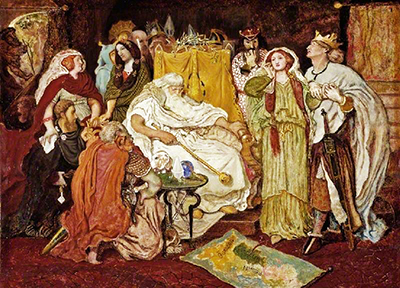Cordelia's Portion is a literary painting, in the romantic style. It's a reproduction from a scene in the Shakespearean tragedy, King Lear. Colourful and dramatic, it presents a fairly crowded scene. But if the viewer is familiar with the story, the painting will make sense.
We can see the king, dejected and disappointed. Dividing up his kingdom among his three daughters, he had requested that they assure him of their love. The two elder sisters, Regan and Goneril had praised the king to the skies and assured him of their undying devotion while the youngest, Cordelia had merely assured his majesty that she loved him according to her filial duty. Disappointed, her father had divided up her portion between her two sisters. We notice the two sisters exchanging knowing glances while Cordelia stands, shocked and disowned. The two sons-in-law are kneeling in submission before the king. The courtiers are as shocked as Cordelia is.
The old man's love of flattery has created a situation which will end in tragedy. After this scene, things will only get worse. Cordelia’s faithful suitor holds her hand, assuring her that he is standing by her in steadfast faith. But the inevitable tragedy will ensue. This painting is full of drama and emotion. It has been created from watercolours, using the gouache technique. This technique involved adding an opaque substance to the watercolour paint to produce a rich, colourful effect. Today, this work of art is in the possession of the Southampton City Art Gallery. It was enquired by the gallery in 1936.
Cordelia's Portion is the work of the 19th-century painter, Ford Madox Brown. He was influenced by the Romantic and pre-Raphaelite movements, which were influential during his lifetime. Brown was born in France to English parents. He lived much of his life on the European continent but was essentially a British painter. He received his art education in Belgium, studying art both in Bruges and Antwerp between 1835 and 1837. His paintings often depicted tragic and dramatic happenings and Ford Madox Brown appears to have experienced several personal tragedies. He married twice. His first wife, his cousin Elizabeth Bromley, died at the age of 27 of pulmonary tuberculosis. He later married Emma Hill, one of his models. Several children were born to the artist and his two spouses, but tragically most of them died young, with the exception of two daughters. The novelist Ford Madox Ford was his grandson.




